Cohen I.M., Kundu P.K. Fluid Mechanics
Подождите немного. Документ загружается.

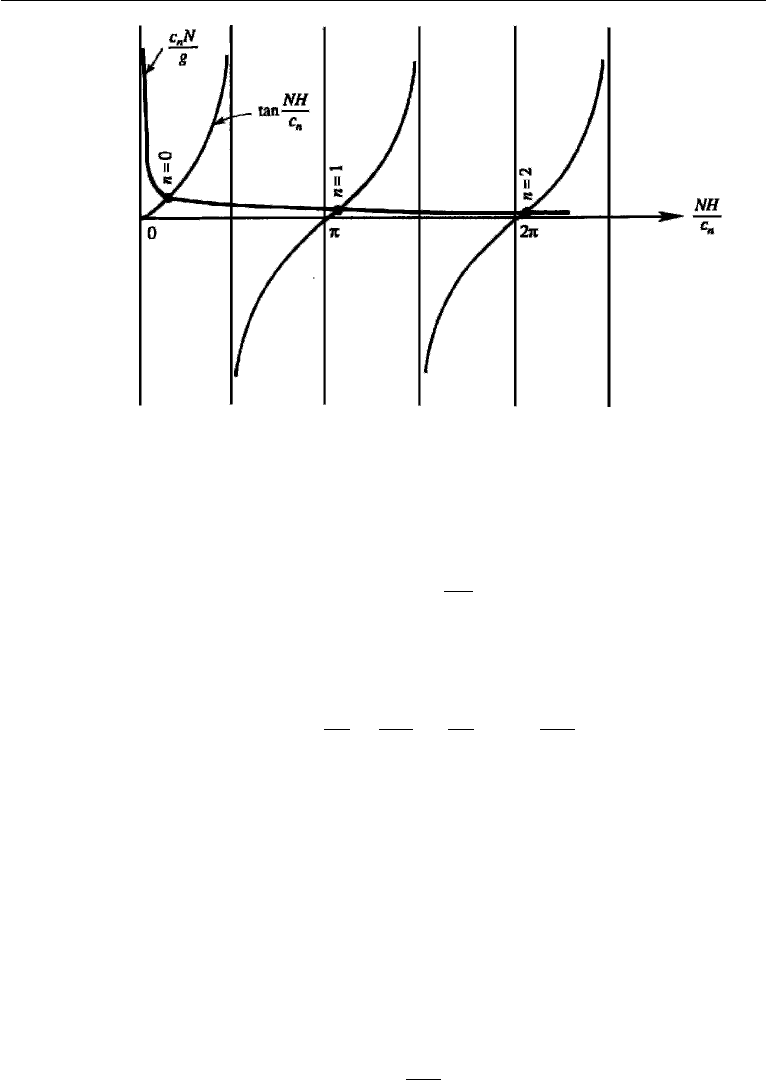
632 Geophysical Fluid Dynamics
Figure 14.12 Calculation of eigenvalues c
n
of vertical normal modes in a fluid layer of depth H and
uniform stratification N.
The solution of equation (14.70) is indicated graphically in Figure 14.12. The
first root occurs for NH/c
n
1, for which we can write tan(NH /c
n
) NH/c
n
,
so that equation (14.70) gives (indicating this root by n = 0)
c
0
=
gH.
The vertical modal structure is found from equation (14.69). Because the magnitude
of an eigenfunction is arbitrary, we can set A
0
= 1, obtaining
ψ
0
= cos
Nz
c
0
−
c
0
N
g
sin
Nz
c
0
1 −
N
2
z
g
1,
where we have used N|z|/c
0
1 (with NH/c
0
1), and N
2
z/g 1 (with
N
2
H/g = (N H /c
0
)(c
0
N/g) 1, both sides of equation (14.70) being much less
than 1). For this mode the vertical structure of u, v, and p is therefore nearly
depth-independent. The corresponding structure for w (given by
ψ
0
dz, as indi-
cated in equation (14.53)) is linear in z, with zero at the bottom and a maximum at the
upper free surface. A stratified medium therefore has a mode of motion that behaves
like that in an unstratified medium; this mode does not feel the stratification. The
n = 0 mode is called the barotropic mode.
The remaining modes n 1 are baroclinic. For these modes c
n
N/g 1but
NH/c
n
is not small, as can be seen in Figure 14.12, so that the baroclinic roots of
equation (14.70) are nearly given by
tan
NH
c
n
= 0,

9. Normal Modes in a Continuously Stratified Layer 633
which gives
c
n
=
NH
nπ
,
n = 1, 2, 3,.... (14.71)
Taking a typical depth-average oceanic value of N ∼ 10
−3
s
−1
and H ∼ 5 km, the
eigenvalue for the first baroclinic mode is c
1
∼ 2m/s. The corresponding equivalent
depth is H
e
= c
2
1
/g ∼ 0.4m.
An examination of the algebraic steps leading to equation (14.70) shows that
neglecting the right-hand side is equivalent to replacing the upper boundary condi-
tion (14.65
)byw = 0atz = 0. This is called the rigid lid approximation. The
baroclinic modes are negligibly distorted by the rigid lid approximation. In contrast,
the rigid lid approximation applied to the barotropic mode would yield c
0
=∞,as
equation (14.71) shows for n = 0. Note that the rigid lid approximation does not
imply that the free surface displacement corresponding to the baroclinic modes is
negligible in the ocean. In fact, excluding the wind waves and tides, much of the
free surface displacements in the ocean are due to baroclinic motions. The rigid lid
approximation merely implies that, for baroclinic motions, the vertical displacements
at the surface are much smaller than those within the fluid column. A valid baroclinic
solution can therefore be obtained by setting w = 0atz = 0. Further, the rigid lid
approximation does not imply that the pressure is constant at the level surface z = 0;
if a rigid lid were actually imposed at z = 0, then the pressure on the lid would vary
due to the baroclinic motions.
The vertical mode shape under the rigid lid approximation is given by the cosine
distribution
ψ
n
= cos
nπz
H
,n= 0, 1, 2,...,
because it satisfies dψ
n
/dz = 0atz = 0, −H . The nth mode ψ
n
has n zero crossings
within the layer (Figure 14.13).
A decomposition into normal modes is only possible in the absence of
topographic variations and mean currents with shear. It is valid with or without Cori-
olis forces and with or without the β-effect. However, the hydrostatic approximation
here means that the frequencies are much smaller than N . Under this condition the
eigenfunctions are independent of the frequency, as equation (14.56) shows. With-
out the hydrostatic approximation the eigenfunctions ψ
n
become dependent on the
frequency ω. This is discussed, for example, in LeBlond and Mysak (1978).
Summary: Small amplitude motion in a frictionless continuously stratified ocean
can be decomposed in terms of noninteracting vertical normal modes. The vertical
structure of each mode is defined by an eigenfunction ψ
n
(z). If the horizontal scale
of the waves is much larger than the vertical scale, then the equations governing
the horizontal propagation of each mode are identical to those of a shallow homo-
geneous layer, with the layer depth H replaced by an equivalent depth H
e
defined
by c
2
n
= gH
e
. For a medium of constant N , the baroclinic (n 1) eigenvalues are
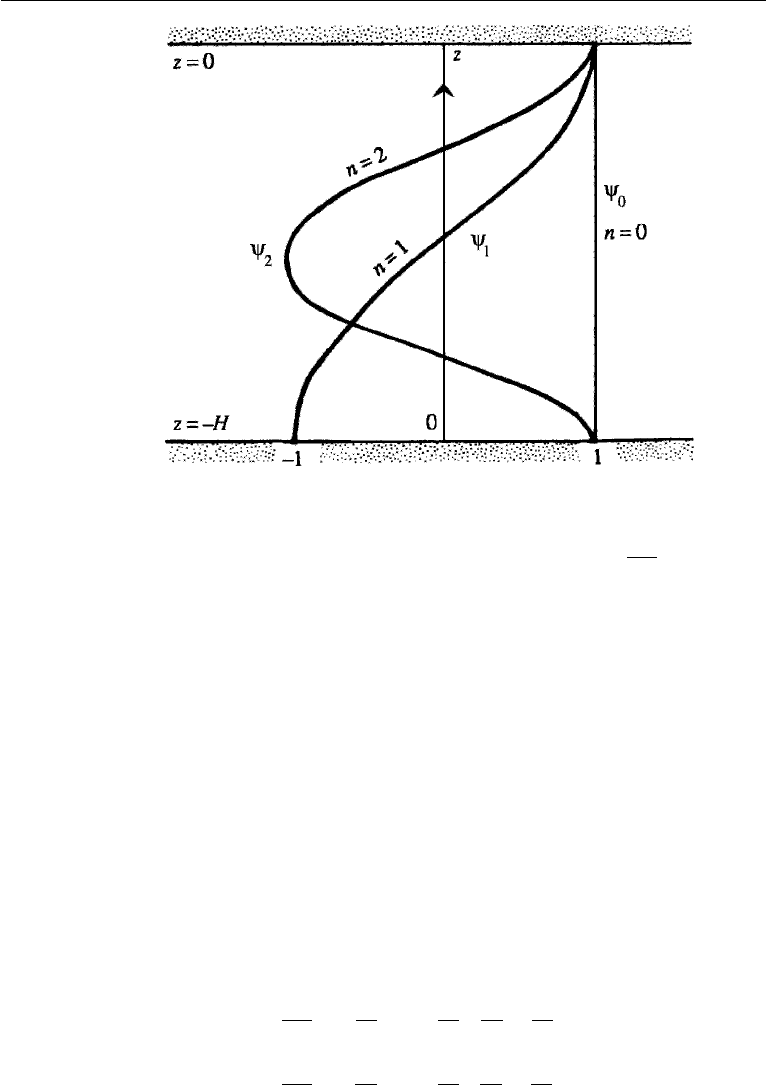
634 Geophysical Fluid Dynamics
Figure 14.13 Vertical distribution of a few normal modes in a stratified medium of uniform buoyancy
frequency.
given by c
n
= NH/π n, while the barotropic eigenvalue is c
0
=
√
gH. The rigid lid
approximation is quite good for the baroclinic modes.
10. High- and Low-Frequency Regimes in
Shallow-Water Equations
We shall now examine what terms are negligible in the shallow-water equations for
the various frequency ranges. Our analysis is valid for a single homogeneous layer
or for a stratified medium. In the latter case H has to be interpreted as the equivalent
depth, and c has to be interpreted as the speed of long nonrotating internal gravity
waves. The β-effect will be considered in this section. As f varies only northward,
horizontal isotropy is lost whenever the β-effect is included, and it becomes necessary
to distinguish between the different horizontal directions. We shall follow the usual
geophysical convention that the x-axis is directed eastward and the y-axis is directed
northward, with u and v the corresponding velocity components.
The simplest way to perform the analysis is to examine the v-equation. A single
equation for v can be derived by first taking the time derivatives of the momentum
equations in (14.45) and using the continuity equation to eliminate ∂η/∂t. This gives
∂
2
u
∂t
2
− f
∂v
∂t
= gH
∂
∂x
∂u
∂x
+
∂v
∂y
, (14.72)
∂
2
v
∂t
2
+ f
∂u
∂t
= gH
∂
∂y
∂u
∂x
+
∂v
∂y
. (14.73)

10. High- and Low-Frequency Regimes in Shallow-Water Equations 635
Now take ∂/∂t of equation (14.73) and use equation (14.72), to obtain
∂
3
v
∂t
3
+ f
f
∂v
∂t
+ gH
∂
∂x
∂u
∂x
+
∂v
∂y
= gH
∂
2
∂y ∂t
∂u
∂x
+
∂v
∂y
. (14.74)
To eliminate u, we first obtain a vorticity equation by cross differentiating and sub-
tracting the momentum equations in equation (14.45):
∂
∂t
∂u
∂y
−
∂v
∂x
− f
0
∂u
∂x
+
∂v
∂y
− βv = 0.
Here, we have made the customary β-plane approximation, valid if the y-scale is small
enough so that f /f 1. Accordingly, we have treated f as constant (and replaced
it by an average value f
0
) except when df/dy appears; this is why we have written
f
0
in the second term of the preceding equation. Taking the x-derivative, multiplying
by gH, and adding to equation (14.74), we finally obtain a vorticity equation in terms
of v only:
∂
3
v
∂t
3
− gH
∂
∂t
∇
2
H
v + f
2
0
∂v
∂t
− gHβ
∂v
∂x
= 0,
(14.75)
where ∇
2
H
= ∂
2
/∂x
2
+ ∂
2
/∂y
2
is the horizontal Laplacian operator.
Equation (14.75) is Boussinesq, linear and hydrostatic, but otherwise quite gen-
eral in the sense that it is applicable to both high and low frequencies. Consider wave
solutions of the form
v =ˆve
i(kx+ly−ωt)
,
where k is the eastward wavenumber and l is the northward wavenumber. Then equa-
tion (14.75) gives
ω
3
− c
2
ωK
2
− f
2
0
ω − c
2
βk = 0, (14.76)
where K
2
= k
2
+l
2
and c =
√
gH. It can be shown that all roots of equation (14.76)
are real, two of the roots being superinertial (ω>f) and the third being subinertial
(ω f ). Equation (14.76) is the complete dispersion relation for linear shallow-water
equations. In various parametric ranges it takes simpler forms, representing simpler
waves.
First, consider high-frequency waves ω f . Then the third term of equa-
tion (14.76) is negligible compared to the first term. Moreover, the fourth term is
also negligible in this range. Compare, for example, the fourth and second terms:
c
2
βk
c
2
ωK
2
∼
β
ωK
∼ 10
−3
,

636 Geophysical Fluid Dynamics
where we have assumed typical values of β = 2 × 10
−11
m
−1
s
−1
, ω = 3f
∼ 3 ×10
−4
s
−1
, and 2π/K ∼ 100 km. For ω f , therefore, the balance is between
the first and second terms in equation (14.76), and the roots are ω =±K
√
gH, which
correspond to a propagation speed of ω/K =
√
gH. The effects of both f and β are
therefore negligible for high-frequency waves, as is expected as they are too fast to
be affected by the Coriolis effects.
Next consider ω>f,butω ∼ f . Then the third term in equation (14.76) is not
negligible, but the β-effect is. These are gravity waves influenced by Coriolis forces;
gravity waves are discussed in the next section. However, the time scales are still too
short for the motion to be affected by the β-effect.
Last, consider very slow waves for which ω f . Then the β-effect becomes
important, and the first term in equation (14.76) becomes negligible. Compare, for
example, the first and the last terms:
ω
3
c
2
βk
1.
Typical values for the ocean are c ∼ 200 m/s for the barotropic mode, c ∼ 2m/s for
the baroclinic mode, β = 2 × 10
−11
m
−1
s
−1
,2π/k ∼ 100 km, and ω ∼ 10
−5
s
−1
.
This makes the forementioned ratio about 0.2 × 10
−4
for the barotropic mode and
0.2 for the baroclinic mode. The first term in equation (14.76) is therefore negligible
for ω f .
Equation (14.75) governs the dynamics of a variety of wave motions in the
ocean and the atmosphere, and the discussion in this section shows what terms can
be dropped under various limiting conditions. An understanding of these limiting
conditions will be useful in the following sections.
11. Gravity Waves with Rotation
In this chapter we shall examine several free-wave solutions of the shallow-water
equations. In this section we shall study gravity waves with frequencies in the
range ω>f, for which the β-effect is negligible, as demonstrated in the preced-
ing section. Consequently, the Coriolis frequency f is regarded as constant here.
Consider progressive waves of the form
(u, v, η) = ( ˆu, ˆv, ˆη)e
i(kx+ly−ωt)
,
where ˆu, ˆv, and ˆη are the complex amplitudes, and the real part of the right-hand side
is meant. Then equation (14.45) gives
−iωˆu − f ˆv =−ikg ˆη, (14.77)
−iωˆv + f ˆu =−ilg ˆη, (14.78)
−iωˆη + iH(k ˆu + l ˆv) = 0. (14.79)
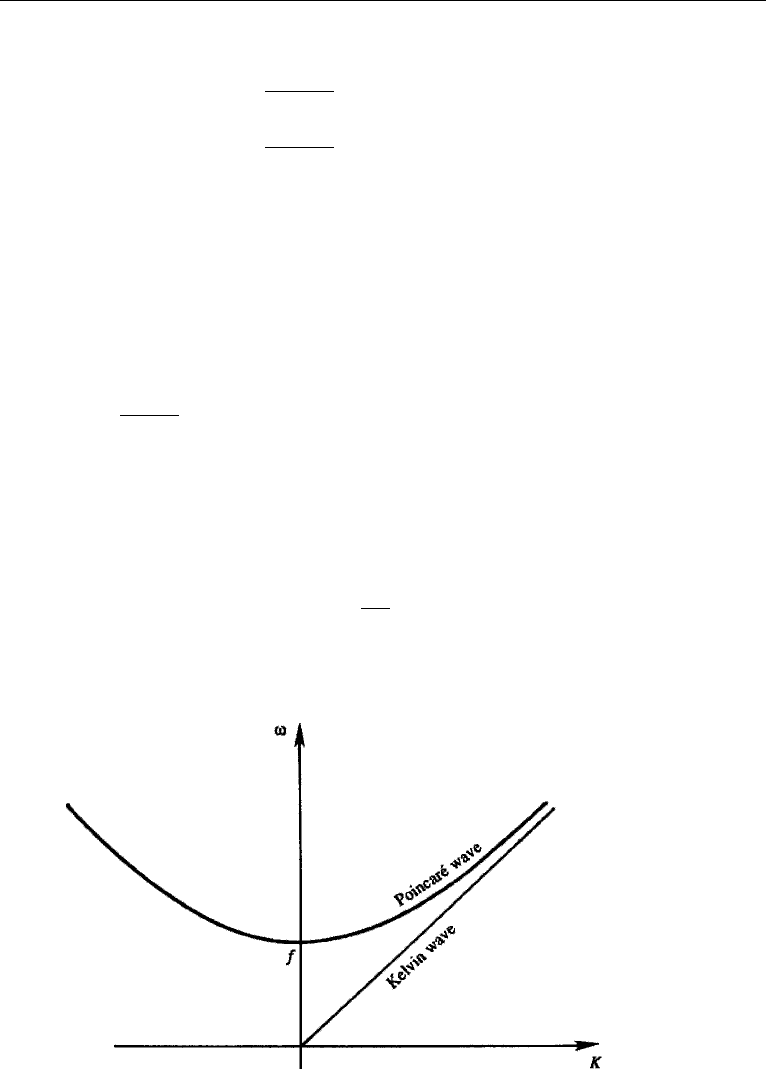
11. Gravity Waves with Rotation 637
Solving for ˆu and ˆv between equations (14.77) and (14.78), we obtain
ˆu =
g ˆη
ω
2
− f
2
(ωk + if l),
ˆv =
g ˆη
ω
2
− f
2
(−if k + ωl).
(14.80)
Substituting these in equation (14.79), we obtain
ω
2
− f
2
= gH(k
2
+ l
2
). (14.81)
This is the dispersion relation of gravity waves in the presence of Coriolis forces.
(The relation can be most simply derived by setting the determinant of the set of linear
homogeneous equations (14.77)–(14.79) to zero.) It can be written as
ω
2
= f
2
+ gH K
2
, (14.82)
where K =
√
k
2
+ l
2
is the magnitude of the horizontal wavenumber. The disper-
sion relation shows that the waves can propagate in any horizontal direction and have
ω>f. Gravity waves affected by Coriolis forces are called Poincar´e waves, Sverdrup
waves, or simply rotational gravity waves. (Sometimes the name “Poincar´e wave” is
used to describe those rotational gravity waves that satisfy the boundary conditions
in a channel.) In spite of their name, the solution was first worked out by Kelvin (Gill,
1982, p. 197). A plot of equation (14.82) is shown in Figure 14.14. It is seen that the
waves are dispersive except for ω f when equation (14.82) gives ω
2
gHK
2
,
so that the propagation speed is ω/K =
√
gH. The high-frequency limit agrees
with our previous discussion of surface gravity waves unaffected by Coriolis
forces.
Figure 14.14 Dispersion relations for Poincar´e and Kelvin waves.
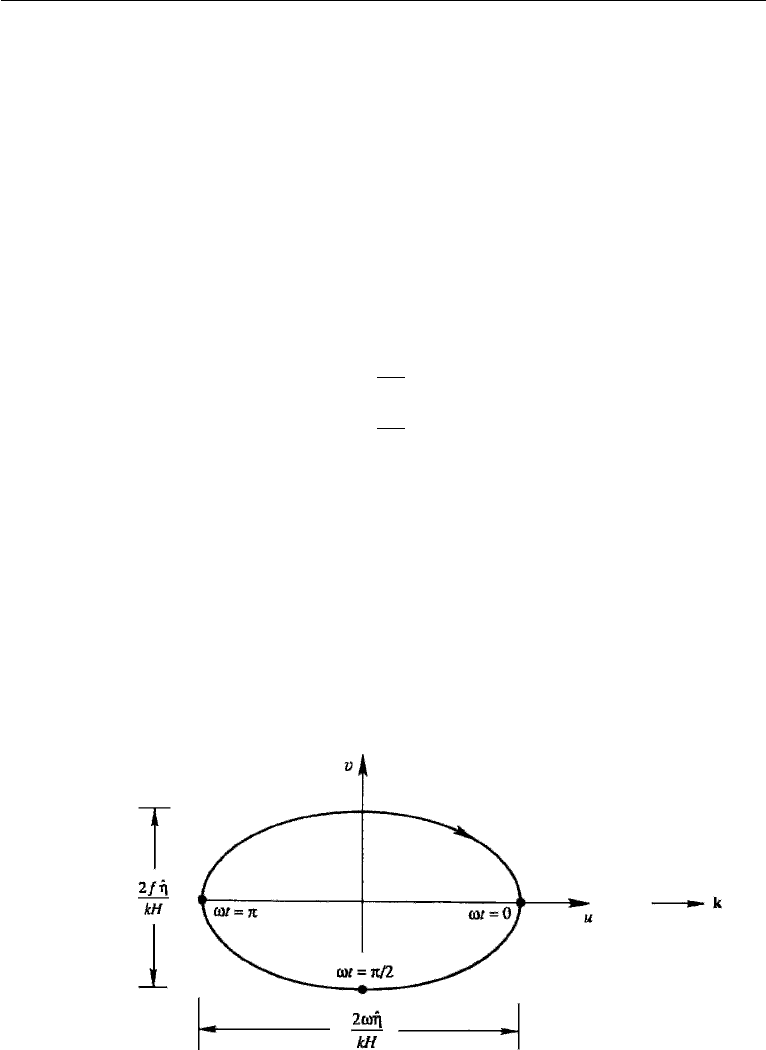
638 Geophysical Fluid Dynamics
Particle Orbit
The symmetry of the dispersion relation (14.81) with respect to k and l means that the
x- and y-directions are not felt differently by the wavefield. The horizontal isotropy
is a result of treating f as constant. (We shall see later that Rossby waves, which
depend on the β-effect, are not horizontally isotropic.) We can therefore orient the
x-axis along the wavenumber vector and set l = 0, so that the wavefield is invariant
along the y-axis. To find the particle orbits, it is convenient to work with real quantities.
Let the displacement be
η =ˆη cos(kx − ωt),
where ˆη is real. The corresponding velocity components can be found by multiplying
equation (14.80) by exp(ikx −iωt) and taking the real part of both sides. This gives
u =
ω ˆη
kH
cos(kx − ωt),
v =
f ˆη
kH
sin(kx − ωt).
(14.83)
To find the particle paths, take x = 0 and consider three values of time corresponding
to ωt = 0, π/2, and π. The corresponding values of u and v from equation (14.83)
show that the velocity vector rotates clockwise (in the northern hemisphere) in elliptic
paths (Figure 14.15). The ellipticity is expected, since the presence of Coriolis forces
means that fu must generate ∂v/∂t according to the equation of motion (14.45).
(In equation (14.45), ∂η/∂y = 0 due to our orienting the x-axis along the direction
of propagation of the wave.) Particles are therefore constantly deflected to the right
by the Coriolis force, resulting in elliptic orbits. The ellipses have an axis ratio of
ω/f, and the major axis is oriented in the direction of wave propagation. The ellipses
become narrower as ω/f increases, approaching the rectilinear orbit of gravity waves
Figure 14.15 Particle orbit in a rotational gravity wave. Velocity components corresponding to ωt = 0,
π/2, and π are indicated.

12. Kelvin Wave 639
unaffected by planetary rotation. However, the sea surface in a rotational gravity wave
is no different than that for ordinary gravity waves, namely oscillatory in the direction
of propagation and invariant in the perpendicular direction.
Inertial Motion
Consider the limit ω → f , that is when the particle paths are circular. The dispersion
relation (14.82) then shows that K → 0, implying a horizontal uniformity of the flow
field. Equation (14.79) shows that ˆη must tend to zero in this limit, so that there
are no horizontal pressure gradients in this limit. Because ∂u/∂x = ∂v/∂y = 0, the
continuity equation shows that w = 0. The particles therefore move on horizontal
sheets, each layer decoupled from the one above and below it. The balance of forces is
∂u
∂t
− fv = 0,
∂v
∂t
+ fu = 0.
The solution of this set is of the form
u = q cos ft,
v =−q sin ft,
where the speed q =
√
u
2
+ v
2
is constant along the path. The radius r of the orbit
can be found by adopting a Lagrangian point of view, and noting that the equilibrium
of forces is between the Coriolis force fq and the centrifugal force rω
2
= rf
2
,
giving r = q/f. The limiting case of motion in circular orbits at a frequency f is
called inertial motion, because in the absence of pressure gradients a particle moves
by virtue of its inertia alone. The corresponding period 2π/f is called the inertial
period. In the absence of planetary rotation such motion would be along straight
lines; in the presence of Coriolis forces the motion is along circular paths, called
inertial circles. Near-inertial motion is frequently generated in the surface layer of
the ocean by sudden changes of the wind field, essentially because the equations of
motion (14.45) have a natural frequency f . Taking a typical current magnitude of
q ∼ 0.1m/s, the radius of the orbit is r ∼ 1 km.
12. Kelvin Wave
In the preceding section we considered a shallow-water gravity wave propagating in
a horizontally unbounded ocean. We saw that the crests are horizontal and oriented in
a direction perpendicular to the direction of propagation. The absence of a transverse
pressure gradient ∂η/∂y resulted in a transverse flow and elliptic orbits. This is clear
from the third equation in (14.45), which shows that the presence of fumust result in
∂v/∂t if ∂η/∂y = 0. In this section we consider a gravity wave propagating parallel
to a wall, whose presence allows a pressure gradient ∂η/∂y that can decay away from
the wall. We shall see that this allows a gravity wave in which fuis geostrophically
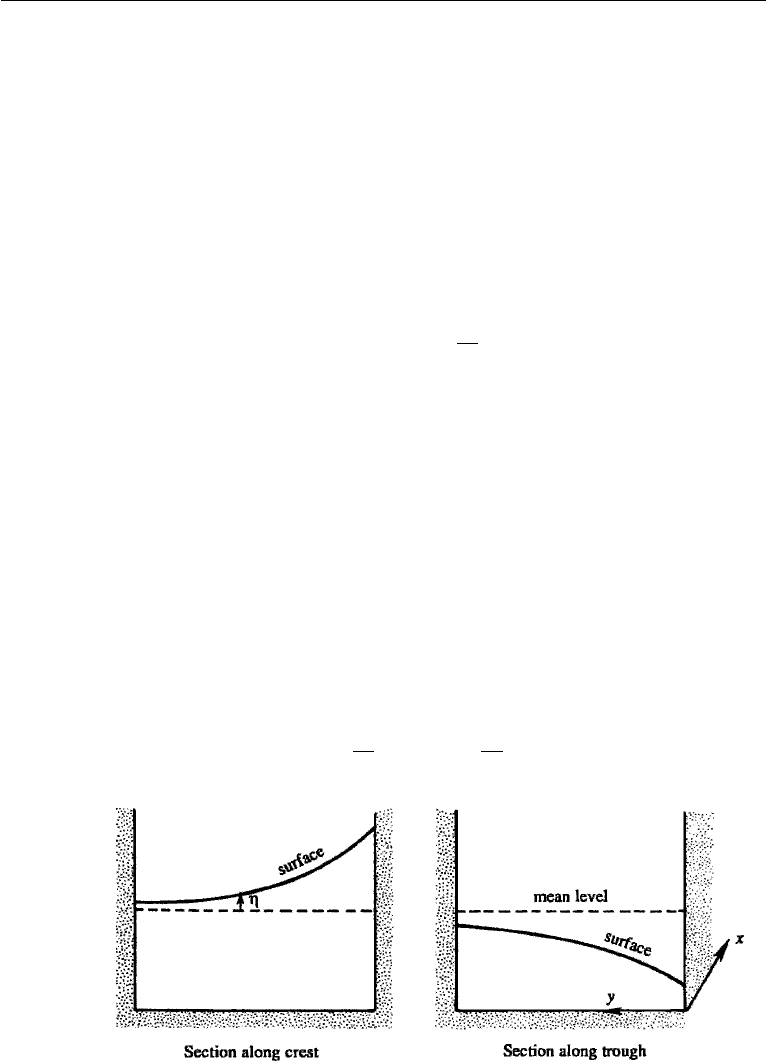
640 Geophysical Fluid Dynamics
balanced by −g(∂η/∂y), and v = 0. Consequently the particle orbits are not elliptic
but rectilinear.
Consider first a gravity wave propagating in a channel. From Figure 7.7 we know
that the fluid velocity under a crest is “forward” (i.e., in the direction of propagation),
and that under a trough it is backward. Figure 14.16 shows two transverse sections of
the wave, one through a crest (left panel) and the other through a trough (right panel).
The wave is propagating into the plane of the paper, along the x-direction. Then the
fluid velocity under the crest is into the plane of the paper and that under the trough is
out of the plane of the paper. The constraints of the side walls require that v = 0 at the
walls, and we are exploring the possibility of a wave motion in which v is zero every-
where. Then the equation of motion along the y-direction requires that fucan only be
geostrophically balanced by a transverse slope of the sea surface across the channel:
fu=−g
∂η
∂y
.
In the northern hemisphere, the surface must slope as indicated in the figure, that is
downward to the left under the crest and upward to the left under the trough, so that
the pressure force has the current directed to its right. The result is that the amplitude
of the wave is larger on the right-hand side of the channel, looking into the direction
of propagation, as indicated in Figure 14.16. The current amplitude, like the surface
displacement, also decays to the left.
If the left wall in Figure 14.16 is moved away to infinity, we get a gravity wave
trapped to the coast (Figure 14.17). A coastally trapped long gravity wave, in which
the transverse velocity v = 0 everywhere, is called a Kelvin wave. It is clear that it can
propagate only in a direction such that the coast is to the right (looking in the direction
of propagation) in the northern hemisphere and to the left in the southern hemisphere.
The opposite direction of propagation would result in a sea surface displacement
increasing exponentially away from the coast, which is not possible.
An examination of the transverse momentum equation
∂v
∂t
+ fu =−g
∂η
∂y
,
Figure 14.16 Free surface distribution in a gravity wave propagating through a channel into the plane of
the paper.
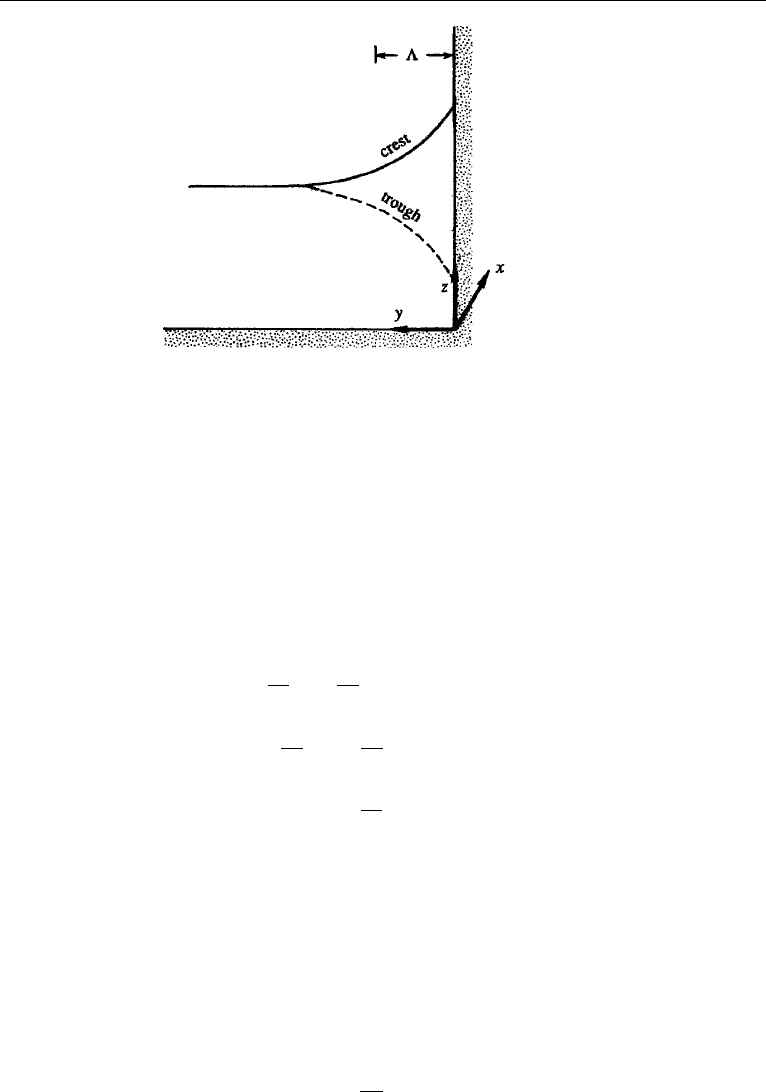
12. Kelvin Wave 641
Figure 14.17 Coastal Kelvin wave propagating along the x-axis. Sea surface across a section through a
crest is indicated by the continuous line, and that along a trough is indicated by the dashed line.
reveals fundamental differences between Poincar´e waves and Kelvin waves. For a
Poincar´e wave the crests are horizontal, and the absence of a transverse pressure
gradient requires a ∂v/∂t to balance the Coriolis force, resulting in elliptic orbits. In a
Kelvin wave a transverse velocity is prevented by a geostrophic balance of fu and
−g(∂η/∂y).
From the shallow-water set (14.45), the equations of motion for a Kelvin wave
propagating along a coast aligned with the x-axis (Figure 14.17) are
∂η
∂t
+ H
∂u
∂x
= 0,
∂u
∂t
=−g
∂η
∂x
, (14.84)
fu=−g
∂η
∂y
.
Assume a solution of the form
[u, η]=[ˆu(y), ˆη(y)]e
i(kx−ωt)
.
Then equation (14.84) gives
−iωˆη + iHk ˆu = 0,
−iωˆu =−igk ˆη, (14.85)
f ˆu =−g
d ˆη
dy
.
